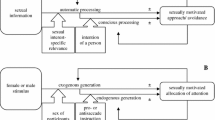Abstract
The concept Sexual Content-Induced Delay (SCID) refers to a hesitancy in decision making related to erotic material (Geer & Bellard, 1996; Geer & Melton, 1997). Empirical evidence about SCID stems from lexical decision tasks. Our previous studies also showed SCID effects in sex versus neutral categorization tasks in which pictures were used. In these tasks, recognition of sexual pictures is delayed when preceded by consciously presented sexual primes. In the current study, 2 manipulations were added to the categorization task to investigate underlying information processing mechanisms of SCID. Firstly, the appraisal process was influenced by varying the instructions. Secondly, primes with nonsexual emotional content were added to test the specificity of the SCID effect. Thirty-seven undergraduates were asked to categorize sexual and neutral pictures that were primed by sexual, threatening, and neutral primes. Participants ignored or focussed prime content dependent on 2 different instructions. Results showed that the SCID effect only emerged when sexual primes were ignored; however, threatening primes also decelerated recognition of sexual pictures after the ignore instruction. Results of the focus instruction were qualitatively different, that is, participants recognized sexual pictures faster when primed sexually. It was suggested that SCID can be interpreted as the activation of regulatory modules by emotional stimuli in the stage of elicitation of emotional response. In contrast, when the sexual system is already activated, it appears that decisions regarding sexual information are facilitated.
Similar content being viewed by others
REFERENCES
Abel, G. G., Huffman, J., Warberg, B., & Holland, C. L. (1998). Visual reaction time and plethysmography as measures of sexual interest in child molesters. Sexual Abuse: A Journal of Research and Treatment, 10, 81-95.
Barlow, D. H. (1986). Causes of sexual dysfunction: The role of anxiety and cognitive interference. Journal of Consulting and Clinical Psychology, 54, 140-148.
Collins, A. M., & Loftus, E. F. (1975). A spreading activation theory of semantic processing. Psychological Review, 82, 407-428.
Everaerd, W. (1995). Information processing approach and the sexual response in human studies. In J. Bancroft (Ed.), The pharmacology of sexual function and dysfunction: Proceedings of the Esteve Foundation Symposium VI (pp. 175-184). Amsterdam: Excerpta Medica.
Geer, J. H., & Bellard, H. S. (1996). Sexual content induced delays in unprimed lexical decisions: Gender and context effects. Archives of Sexual Behavior, 25, 379-395.
Geer, J. H., Lapour, K. J., & Jackson, S. R. (1993). The information processing approach to human sexuality. In N. Birbaumer & A. Öhman (Eds.), The structure of emotion: Psychophysiological, cognitive, and clinical aspects (pp. 139-155). Toronto, Canada: Hogrefe-Huber.
Geer, J. H., & Manguno-Mire, G. M. (1996). Gender differences in cognitive processes in sexuality. Annual Review of Sex Research, 7, 90-124.
Geer, J. H., & Melton, J. S. (1997). Sexual content-induced delay with double-entendre words. Archives of Sexual Behavior, 26, 295-316.
Janssen, E., Everaerd, W., Spiering, M., & Janssen, J. (2000). Automatic cognitive processes and the appraisal of sexual stimuli: Towards an information processing model of sexual arousal. Journal of Sex Research, 37, 8-23.
Lang, P. J., Öhman, A., & Vaitl, D. (1988). The International Affective Picture System [Photographic slides]. Gainesville: Center for Research in Psychophysiology, University of Florida.
Lazarus, R. S., Kanner, A. D., & Folkman, S. (1980). Emotions: A cognitive-phenomenological analysis. In R. Plutchik & H. Kellerman (Eds.), Emotion: Theory, research, and experience: Vol.1.Theories of emotion (pp. 189-217). New York: Academic Press.
Milliken, B., Joordens, S., Merikle, P. M., & Seiffert, A. E. (1998). Selective attention: A reevaluation of the implications of negative priming. Psychological Review, 105, 203-229.
Mogg, K., Mathews, A., & Eysenck, M. (1992). Attentional bias to threat in clinical anxiety states. Cognition and Emotion, 6, 149-159.
Pashler, H. (1994). Dual-task interference in simple tasks: Data and theory. Psychological Bulletin, 116, 220-244.
Ratcliff, R. (1993). Methods for dealing with reaction time outliers. Psychological Bulletin, 114, 510-532.
Spiering, M., Everaerd, W., & Laan, E. (2000). Conscious processing of sexual information: Mechanisms of primary appraisal. Manuscript submitted for publication.
Williams, J. M. G., Mathews, A., & MacLeod, C. (1996). The emotional Stroop task and psychopathology. Psychological Bulletin, 120, 3-24.
Wright, L. W., & Adams, H. E. (1999). The effects of stimuli that vary in erotic content on cognitive processes. Journal of Sex Research, 36, 145-151.
Zeelenberg, R., Pecher, D., de Kok, D., & Raaijmakers, J. G.W. (1998). Inhibition from nonword primes in lexical decision reexamined: The critical influence of instruction. Journal of Experimental Psychology: Learning, Memory, and Cognition, 24, 1068-1079.
Author information
Authors and Affiliations
Rights and permissions
About this article
Cite this article
Spiering, M., Everaerd, W. & Elzinga, B. Conscious Processing of Sexual Information: Interference Caused by Sexual Primes. Arch Sex Behav 31, 159–164 (2002). https://doi.org/10.1023/A:1014635102748
Issue Date:
DOI: https://doi.org/10.1023/A:1014635102748




